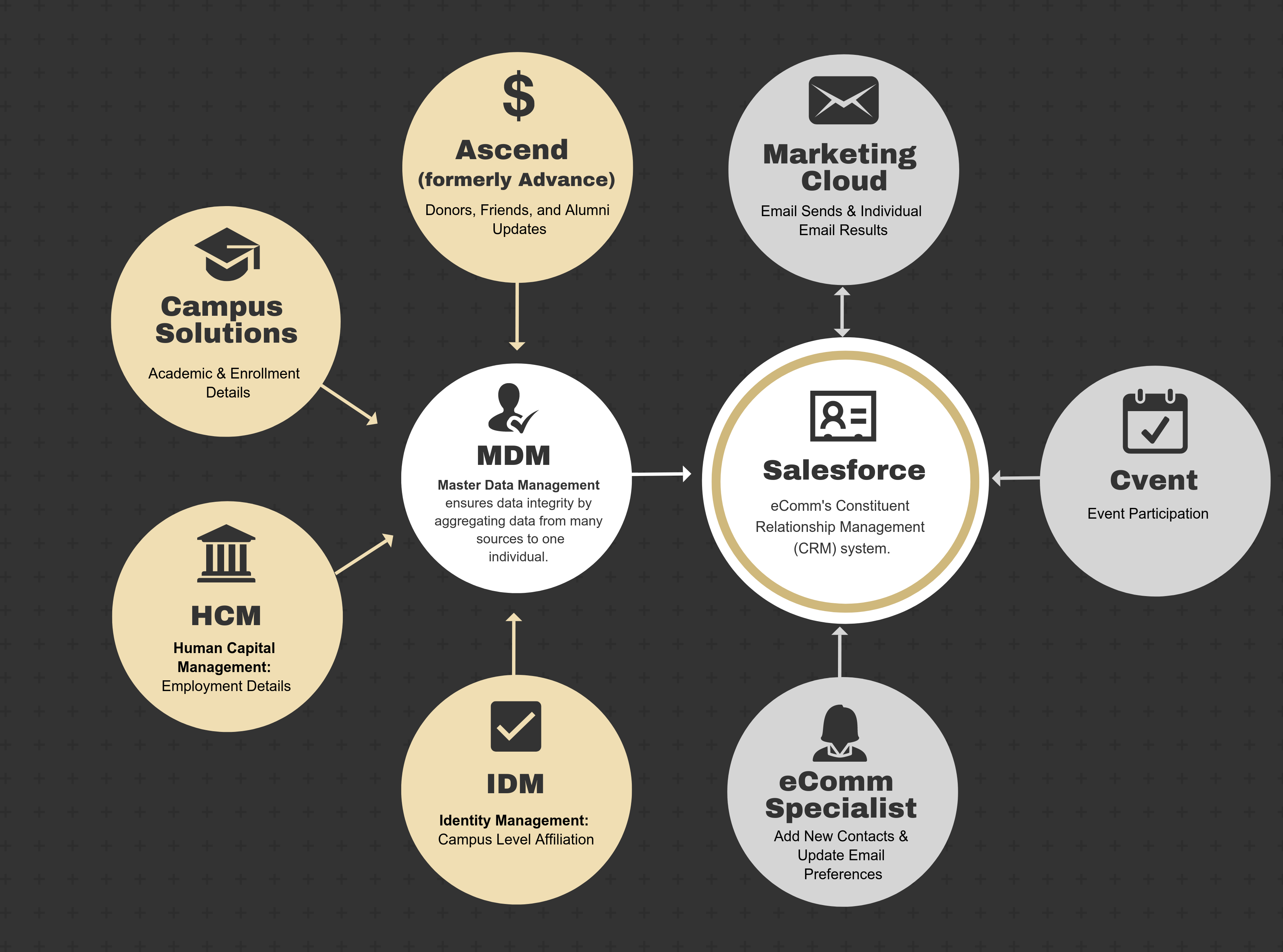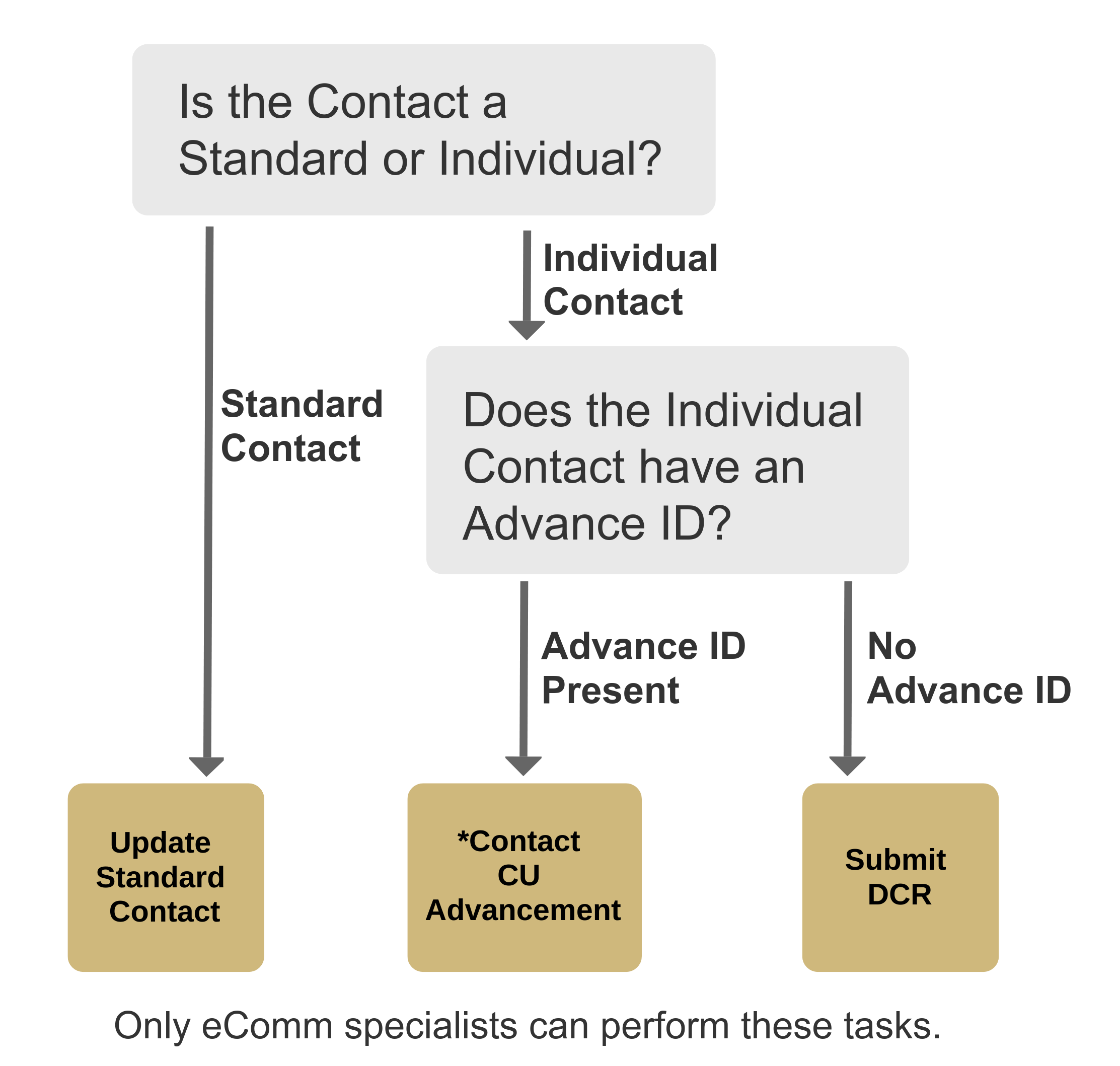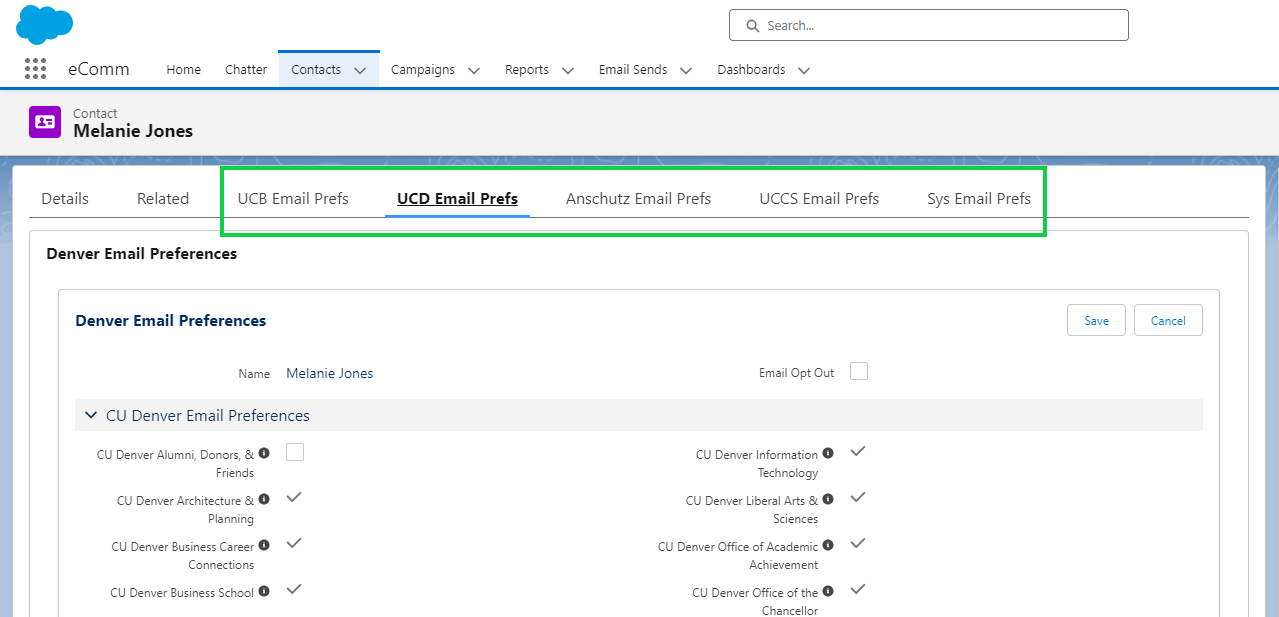eComm Data
Salesforce is at the heart of eComm, but it would be nothing without other systems across CU. Most of eComm's Salesforce Contacts come from a nightly updated source system, enriched with engagement data from eComm's other applications (Marketing Cloud & Cvent), constituents, and eComm Specialists.

- CU Ascend Salesforce | Donors, Friends & Alumni Updates
- Campus Solutions | Academic & Enrollment Details
- Human Capital Management (HCM) | CU Employment Details
- Identity Management (IDM) | Campus-level Affiliations
- eComm Specialist | Contacts that do not exist in one of the above data systems can be created directly in eComm Salesforce by an eComm Specialist. These are called 'Standard' contacts whereas those from a source system are called 'Individual' contacts.
- Salesforce | Enhances a Contact by layering on individual Email Preferences
- Marketing Cloud | Enhances eComm Salesforce by providing Email Sends and adding Individual Email Results (IERs) to a Contact.
- Marketing Cloud and Salesforce have a bi-directional integration meaning a Marketing Cloud email can be distributed to a targeted audience created in Salesforce and data from that email is sent back to Salesforce.
- Cvent | Enhances a Contact by adding event participation (and creates new Contacts when necessary).
- eComm Specialists | Update a constituent's Email Preferences
- Constituents can adjust their Email Preferences by receiving an email and selecting 'Manage My Preferences' in the footer
- CU Ascend Salesforce, Campus Solutions & HCM | Updates constituent's First Name, Last Name, or Email (depending on which source system the Contact originated from)
Data Dictionary & Entity Relationship Diagram (ERD)
The data dictionary provides full descriptions and values of fields that exist in Salesforce while the Entity Relationship Diagram (ERD) indicates how the data is related to one another.
Jan. 2024 Session
FAQs & Resources
Why isn't someone getting my email?
Answer
It could stem from the source system, how the data is merged in Master Data Management (MDM) and relayed to Salesforce, the additional data layered on for CAN-SPAM compliance, how the audience translates to Marketing Cloud or a failed process on the sender's part. As a user, if someone is not getting emails:
- first, ensure the sender is running the Data Extension with success before each send (if applicable). If so,
- provide the missed communication example and the email address of the constituent to your eComm specialist to troubleshoot accordingly.
Resources
How does a constituent's email address get updated?
Answer
For the most part email addresses need to be updated in the source system. The most common example is for alumni/friend/donor populations that must be updated in CU Ascend. Updated email addresses for students or employees are rare, but would also need to be resolved in the source system.
- Recipients can 'Update Your Contact Information' via the footer of commercial emails. This data will be processed accordingly.
- eComm specialists have access to submit Data Change Requests to get changes processed accordingly.
- If the Contact has an Advance ID the eComm specialist will work with those at CU Advancement to get it processed in CU Ascend.
Contacts that do not exist in one of the source systems and were instead created directly in Salesforce (called 'Standard' Contacts) be updated by an eComm specialist. These contacts make up 4% of our total.

*Many, outside of eComm specialists work with CU Advancement to get alumni and donor data processed.
Resources
How does a constituent's email preference get updated?
Answer
- Constituents receiving emails can manage their email preferences via the 'Manage My Preferences' link in the footer of commercial emails.
- eComm specialists can opt contacts in/out of an email category if provided written consent from the constituent. Marketing Cloud users can view which email preferences a contact is opted into or not in Salesforce but do not have access to edit.

Resources
How does a constituent who is opted out get opted back in?
Answer
- If someone is opted out of all emails they cannot manage their email preferences and will need assistance.
- eComm specialists have access to opt contacts back into all emails.
- If someone is not getting emails for other reasons (like they are FERPA protected or marked as 'Do Not Contact') it will require getting fixed in the source system. Your eComm specialist will guide you if they can address the request or recommend the next steps for the constituent.
Resources
- How Constituents Manage Their Email Preferences
- Manually Managing Email Preferences (for eComm Specialists)
Can I export eComm data?
Answer
Not without approval and assistance from your eComm specialist. There are legitimate reasons for exporting eComm data for a defined process or analysis. There are no legitimate reasons for exporting contacts' email addresses to be imported to another platform. This is a violation of both CU and eComm policy and will result in losing your eComm license.





